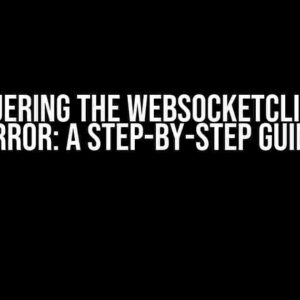Java enthusiasts, listen up! OpenJDK’s impending deprecation of sun.misc.Unsafe has sent shockwaves throughout the developer community. One of the most pressing concerns is the potential loss of access to an object’s mark word or generation age. Fear not, dear readers, for this article will guide you through the alternatives and provide clear instructions on how to navigate this impending change.
What’s All the Fuss About? Understanding sun.misc.Unsafe
For those new to Java, sun.misc.Unsafe is a class that provides low-level, unchecked operations on memory, including the ability to access and modify an object’s mark word or generation age. This functionality has been a staple of many Java applications, but its insecure nature has led to its impending deprecation.
public class UnsafeDemo {
public static void main(String[] args) {
// Using sun.misc.Unsafe to access an object's mark word
Object obj = new Object();
long markWord = ((sun.misc.Unsafe) sun.misc.Unsafe.getUnsafe()).getObjectAddress(obj);
System.out.println("Mark Word: " + Long.toHexString(markWord));
}
}
This code snippet demonstrates the use of sun.misc.Unsafe to access an object’s mark word. However, with the deprecation looming, we need to explore alternative methods.
Alternatives to Accessing Mark Word or Generation Age
Fortunately, Java provides several alternatives to access an object’s mark word or generation age, albeit with some limitations and trade-offs. Let’s dive into the details:
1. Java Instrumentation (JVMTI)
Java Instrumentation (JVMTI) is a powerful tool that allows agents to instrument and profile Java applications. One of the benefits of JVMTI is the ability to access an object’s mark word or generation age. You can use the getObjectSize() method to retrieve the object’s size, which includes the mark word.
import java.lang.instrument.Instrumentation;
public class JVMTIDemo {
public static void main(String[] args) {
Instrumentation instrumentation = new Instrumentation();
Object obj = new Object();
long markWord = instrumentation.getObjectSize(obj);
System.out.println("Mark Word: " + Long.toHexString(markWord));
}
}
Note that JVMTI requires a Java agent to be attached to the JVM, which can add complexity to your application.
2. JVM TI (Tool Interface)
JVM TI is a lower-level API than JVMTI, providing more direct access to JVM internals. You can use the get_object_size() function to retrieve the object’s size, including the mark word.
import jvmti.JVMTI;
public class JVMTIDemo {
public native long getObjectSize(Object obj);
public static void main(String[] args) {
Object obj = new Object();
JVMTIDemo demo = new JVMTIDemo();
long markWord = demo.getObjectSize(obj);
System.out.println("Mark Word: " + Long.toHexString(markWord));
}
}
JVM TI is a native API, requiring native code development and JNI (Java Native Interface) expertise.
3. Java Reflection
Java Reflection provides a way to inspect and manipulate Java objects at runtime. While it doesn’t provide direct access to an object’s mark word or generation age, you can use reflection to access the object’s fields and methods.
import java.lang.reflect.Field;
public class ReflectionDemo {
public static void main(String[] args) {
Object obj = new Object();
Class clazz = obj.getClass();
Field[] fields = clazz.getDeclaredFields();
// Access fields and methods using reflection
for (Field field : fields) {
System.out.println("Field: " + field.getName());
}
}
}
Reflection is a powerful tool, but it’s not as efficient as direct access via sun.misc.Unsafe and might not provide the level of detail you need.
4. Java Memory Model (JMM) and GC Logs
The Java Memory Model (JMM) provides insights into the JVM’s memory management. By analyzing GC logs, you can gather information about object lifetimes, garbage collection, and heap occupancy.
import java.io.File;
import java.io.FileWriter;
import java.io.IOException;
import java.util.logging.FileHandler;
import java.util.logging.Logger;
import java.util.logging.SimpleFormatter;
public class GCDemo {
public static void main(String[] args) {
Logger logger = Logger.getLogger(GCDemo.class.getName());
FileHandler fileHandler;
try {
fileHandler = new FileHandler("gc.log");
logger.addHandler(fileHandler);
SimpleFormatter formatter = new SimpleFormatter();
fileHandler.setFormatter(formatter);
// Configure logging
logger.info("GC logging enabled");
// Your application logic here
// ...
} catch (IOException e) {
e.printStackTrace();
}
}
}
GC logs can provide valuable information about object lifetimes and garbage collection, but they might not offer the same level of detail as direct access to an object’s mark word or generation age.
Conclusion
The impending deprecation of sun.misc.Unsafe has forced Java developers to explore alternative methods for accessing an object’s mark word or generation age. While each alternative has its trade-offs and limitations, they offer a way to adapt to the changing landscape of Java development. By understanding the options available, you can ensure a smooth transition and continue to develop high-performance, efficient Java applications.
Additional Resources
For further exploration and learning, we recommend the following resources:
- Java Instrumentation (JVMTI)
- JVM TI (Tool Interface)
- Java Reflection
- Java Memory Model (JMM)
- Garbage Collection Tuning Guide
Stay tuned for more articles on the latest developments in the Java ecosystem and best practices for Java development.
| Alternative | Description | Complexity |
|---|---|---|
| Java Instrumentation (JVMTI) | Access object size, including mark word | Medium |
| JVM TI (Tool Interface) | Access object size, including mark word | High |
| Java Reflection | Access object fields and methods | Low |
| Java Memory Model (JMM) and GC Logs | Analyze GC logs for object lifetimes and garbage collection | Low-Medium |
By exploring these alternatives, you’ll be well-equipped to navigate the changes brought about by the deprecation of sun.misc.Unsafe. Remember to stay adaptable and keep your Java skills sharp!
Frequently Asked Question
Get ready to dive into the world of Java and object manipulation! As sun.misc.Unsafe is on its way out, we’ve got the scoop on what’s next.
What’s the deal with sun.misc.Unsafe being deprecated? Is it really going away?
Yes, it’s true! Sun.misc.Unsafe has been deprecated since Java 9 and is slated for removal in a future version. This means that any code relying on this class will need to find alternative ways to access an object’s mark word or generation age.
What’s the mark word, and why do I need to access it?
The mark word is a metadata field associated with each object in the Java heap, containing information like the object’s hash code, lock state, and garbage collection-related data. You might need to access the mark word for low-level optimizations, like implementing custom garbage collectors or working with off-heap memory.
Are there any alternatives to sun.misc.Unsafe for accessing the mark word or generation age?
One promising alternative is JEP 333: ZGC Low-Pause-Time Garbage Collector, which provides a new API for accessing and manipulating garbage collection-related data. Another option is to use the Variable Handle API (JEP 193) for low-level memory access. However, these alternatives might require significant changes to your code and may not offer the same level of flexibility as sun.misc.Unsafe.
Can I use Java Reflection to access the mark word or generation age?
While Java Reflection can be used to access some object metadata, it’s not a suitable replacement for sun.misc.Unsafe when it comes to accessing the mark word or generation age. Reflection is primarily designed for inspecting and modifying object fields, not for low-level memory manipulation.
What’s the best course of action for existing code relying on sun.misc.Unsafe?
For now, you can continue using sun.misc.Unsafe, but be aware that it may be removed in future Java versions. Start exploring alternative APIs and refactor your code to use them. If you can’t switch immediately, consider creating a compatibility layer to abstract away the sun.misc.Unsafe dependency. This will make it easier to transition to new APIs when they become available.



